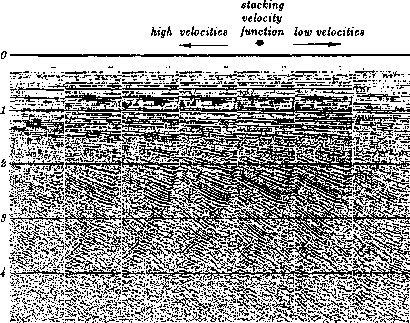Recall Levin's expression for the
travel time of the reflection from
a bed dipping at angle ![]() from the horizontal:
from the horizontal:
| |
(7) |
In (h,t)-space this curve is a hyperbola.
Scaling the velocity by ![]() makes the
travel-time curve identical to
the travel-time curve of the dip-free case.
This is the conventional approach to stacking and velocity analysis.
It is often satisfactory.
Sometimes it is unsatisfactory because the dip angle is
not a single-valued function of space.
For example, near a fault plane there will be diffractions.
They are a superposition of all dips,
each usually being weaker than the reflections.
Many dips are present in the same place.
They blur the velocity estimate and the stack.
makes the
travel-time curve identical to
the travel-time curve of the dip-free case.
This is the conventional approach to stacking and velocity analysis.
It is often satisfactory.
Sometimes it is unsatisfactory because the dip angle is
not a single-valued function of space.
For example, near a fault plane there will be diffractions.
They are a superposition of all dips,
each usually being weaker than the reflections.
Many dips are present in the same place.
They blur the velocity estimate and the stack.
In principle, migration before stack--some kind of implementation of the full DSR equation--solves this general problem. But where do we get the velocity to use in the migration equations? Although migration is somewhat insensitive to velocity when only small angles are involved, migration becomes sensitive to velocity when wide angles are involved.
The migration process should be thought of as being interwoven with the velocity estimation process. J.W.C. Sherwood [1976] showed how the two processes, migration and velocity estimation, should be interwoven. The moveout correction should be considered in two parts, one depending on offset, the NMO, and the other depending on dip. This latter process was conceptually new. Sherwood described the process as a kind of filtering, but he did not provide implementation details. He called his process Devilish, an acronym for ``dipping-event velocity inequalities licked.'' The process was later described more functionally by Yilmaz as prestack partial migration, but the process has finally come to be called simply dip moveout (DMO). We will first see Sherwood's results, then Rocca's conceptual model of the DMO process, and finally two conceptually distinct, quantitative specifications of the process.
Figure 11 contains a panel from a stacked section.
The panel is shown several times; each time the stacking velocity is different. It should be noted that at the low velocities, the horizontal events dominate, whereas at the high velocities, the steeply dipping events dominate. After the Devilish correction was applied, the data was restacked as before. Figure 12 shows that the stacking velocity no longer depends on the dip.
 |
This means that after Devilish, the velocity may be determined without regard to dip. In other words, events with all dips contribute to the same consistent velocity rather than each dipping event predicting a different velocity. So the Devilish process should provide better velocities for data with conflicting dips. And we can expect a better final stack as well.